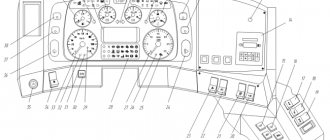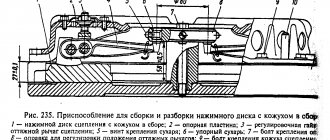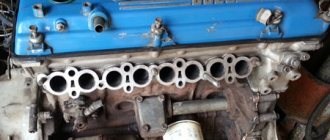Serial production of the most massive truck of the Soviet army and national economy began in 1964. In terms of a number of technical parameters, the car turned out to be quite unique and earned universal recognition, becoming the main cargo transport of the armed forces for many years, equipped with all-wheel drive.
The electrical wiring of the GAZ 66 was structurally simple
Features of electrical equipment
The military purpose of the vehicle imposes certain properties on all its systems and components. In particular, the requirements for electrical equipment are:
- Maximum protection of wiring from induced electromechanical interference;
- Duplication of main components or their backup operation scheme;
- Maximum maintainability in the field with your own hands.
All electrical equipment of the engine is maximally protected from interference and moisture
For reference: the wiring itself had a classic scheme inherent in contact ignition of carburetor engines. However, a number of elements and components were made unique, which was required by operating conditions.
Very often, the GAZ 66 army vehicle carried the functions of electronic reconnaissance and early detection of the enemy. Therefore, the design of electrical equipment provided for maximum protection, because the cost of losing a combat unit could have dire consequences for a combat operation.
Automatic direction finder ARP-11 based on GAZ 66
Ignition system
To protect the ignition system, the GAZ 66 wiring is made in a shielded version:
- The distributor body is placed in a sealed metal cup;
- High-voltage wires to the spark plugs have a metal braid;
- The candles are covered with metal caps that act as a screen.
The protected distributor has a fitting for air supply
The design of the main components is made in such a way that the ignition system remains operational even when overcoming water obstacles. In particular:
- Using a flexible hose, excess pressure is supplied to the distributor body from the receiver, preventing water from penetrating inside;
- High-voltage wires are equipped with sealed caps;
- The ignition coil is also placed in a sealed housing (see also the GAZ 3307 wiring diagram).
Photo of high-voltage wires GAZ 66 in sealed design
For reference: when fording rivers and lakes, the driver was instructed to remove the pulley from the engine cooling fan drive. This is necessary in order to protect the radiator, since in water the fan creates a water jet that can damage it.
Emergency operation circuits were also provided for the ignition system. In particular, the factory instructions in case of failure of the ignition coil or distributor prescribed the following algorithm of actions:
- Disconnect the generator wire from the ignition coil;
- Connect to emergency vibrator;
- Start the engine and maintain the rotation speed no higher than 2000 rpm;
- Move at the same speed for no more than 50 km (see also the GAZ 3110 wiring diagram).
Emergency vibrator 5102.3747 for GAZ 66
When driving on a backup ignition system, the emergency vibrator plays the role of a coil and distributor, constantly generating a spark with a frequency of 250-400 Hz. Wherein:
- engine power decreases, which imposes restrictions on the towed trailer;
- the car can travel another 50 km, which is enough to complete the tasks set by the command.
For reference: subsequent versions of the car had transistor ignition installed. However, as before, the system was equipped with a backup circuit in case of failure of its electronic components.
Lighting system
It is by the lighting fixtures that you can easily distinguish the civilian version of the GAZ 66 from its military original:
- The first generation (from 1963 to 1968) and the second (from 1968 to 1985) were produced exclusively for military needs;
- The third generation of the car (since 1985) received a “registration” in the national economy.
The GAZ 66 blackout headlight is similar to the models installed on tanks
For military models, the most important thing was to ensure camouflage of the car at night, while for civilian versions the task is completely different:
- Ensure visibility of vehicle dimensions on public roads;
- Provide visibility of the road situation to the driver from the cab.
For reference: Beginning in 1981, new lighting devices were installed on the GAZ 66, including larger orange sidelights.
GAZ 66 with “civilian” headlights and side lights
In addition to external lighting devices, there were also civilian versions of the car, intended for use in harsh winter latitudes. In particular, the northern version of the GAZ 66-92 was equipped with:
- Cabin with enhanced thermal insulation;
- Double glazing;
- Additional cabin heater and pre-heater;
- Rechargeable battery with increased capacity;
- Additional fog lights.
Not available:
| № | Part code | Name | Part Information |
| 1107-3816 | Pressure gauge | Not available | |
| 1108-3816 | Pressure gauge | Not available | |
| 12-3717035 | Sealing sleeve | Model 12 Group Electrical equipment Subgroup License plate light Serial part number 035 | Not available |
| 1209-3704 | Ignition switch (1209.3704000) | Not available | |
| 13-1711232 | Ring sealing | Model 13 Group Gearbox Subgroup 1711 Part number 232 | Not available |
| 14-3830-T | Pressure gauge | Not available | |
| 14-3830-U-HL | Pressure gauge | Not available | |
| 14-3830-U-HL-E | Pressure gauge | Not available | |
| 20-1104091 | Sealing sleeve | Model 20 Group Engine power system Subgroup Fuel pipelines Part number 091 | Not available |
| 20-3704024 | screw | Model 20 Group Electrical equipment Subgroup Ignition switch (ignition switch) Part number 024 | Not available |
| 201416-P29 | Bolt M6-6gx12 OST 37.001.123-96 | Galvanizing and passivation coating (zinc with chromating) | Not available |
| 2101-3724124-01 | Protective cover | Model 2101 Group Electrical equipment Subgroup Electrical wires Part number 124 | Not available |
| 220051-P29 | Screw M4-6gx10 OST 37.001.127-81 | Galvanizing and passivation coating (zinc with chromating) | Not available |
| 220103-P29 | Screw M6-6gx12 OST 37.001.127-81 | Galvanizing and passivation coating (zinc with chromating) | Not available |
| 224599-P29 | Screw M5-6gx14 | Galvanizing and passivation coating (zinc with chromating) | Not available |
| 24-5205072-10 | Handle assembly | Model 24 Group Window window Subgroup Windshield wiper and drive Serial part number 072 Additionally Not interchangeable with a part previously released under the same number | Not available |
| 24-5205073 | Insert | Model 24 Group Window window Subgroup Windshield wiper and drive Serial part number 073 | Not available |
| 24-3710 | Hazard switch | Not available | |
| 250462-P29 | Nut M4-6N OST 37.001.124-93 | Galvanizing and passivation coating (zinc with chromating) | Not available |
| 250610-P29 | Nut M8-6N OST 37.001.124-93 | Galvanizing and passivation coating (zinc with chromating) | Not available |
| 251086-P29 | Nut M5-6N OST 37.001.112-91 | Galvanizing and passivation coating (zinc with chromating) | Not available |
| 252132-P29 | Washer 4 | Galvanizing and passivation coating (zinc with chromating) | Not available |
| 252133-P2 | Washer 5T OST 37.001.115-75 | Coating phosphating and oiling | Not available |
| 252155-P29 | Spring washer 8 | Galvanizing and passivation coating (zinc with chromating) | Not available |
| 252155-P29 | Spring washer 8 | Galvanizing and passivation coating (zinc with chromating) | Not available |
| 252173-P29 | Washer 2-5 OST 37.001.145-75 | Galvanizing and passivation coating (zinc with chromating) | Not available |
| 252233-P29 | Washer 2-5 OST 37.001.146-75 | Galvanizing and passivation coating (zinc with chromating) | Not available |
| 290115-P29 | Screw M3x4 GOST 1477-84 | Galvanizing and passivation coating (zinc with chromating) | Not available |
| 297480-P29 | Tube mounting bracket | Galvanizing and passivation coating (zinc with chromating) | Not available |
| 40P-3903174 | Sensor switch instruction plate | Model 40P Group Driver's tools and accessories Subgroup Plates (instruction) Part number 174 | Not available |
| 45-9422-1118 | Screw M6-6gx38 | Not available | |
| 4602-3710 | Switch | Not available | |
| 4607-3710 | Switch | Not available | |
| 51-3704100 | Key | Model 51 Group Electrical equipment Subgroup Ignition switch (ignition switch) Part number 100 | Not available |
| 51-3709051-B | Pen | Model 51 Group Electrical equipment Subgroup Electrical switches (central light switch) Serial part number 051 Additionally Interchangeable with a part previously released under the same number | Not available |
| 5112-3709 | Gas tank switch (5112.3709000) | Not available | |
| 5117-3709 | Gas tank switch (5117. 3709000) | Not available | |
| 51У-3709051 | Pen | Model 51Yu Group Electrical equipment Subgroup Electrical switches (central light switch) Part number 051 | Not available |
| 52-3724053 | Wire from the fuel level indicator to the warning lamp assembly | Model 52 Group Electrical equipment Subgroup Electrical wires Part number 053 | Not available |
| 52-50-3724053 | Wire assembly | Model 52-50 Group Electrical equipment Subgroup Electrical wires Part number 053 | Not available |
| 53-12-3552065 | Bracket | Model 53-12 Group Brakes Subgroup Pipeline (hydraulic) booster Part number 065 | Not available |
| 53-3709030 | Nut for securing the central light switch | Model 53 Group Electrical equipment Subgroup Electrical switches (central light switch) Part number 030 | Not available |
| 53-3709038 | Washer for fastening the central light switch | Model 53 Group Electrical equipment Subgroup Electrical switches (central light switch) Part number 038 | Not available |
| 53A-3709010 | Central light switch P312 | Model 53A Group Electrical equipment Subgroup Electrical switches (central light switch) Part number 010 | Not available |
| 66-01-3731040 | bracket | Model 66-01 Group Electrical equipment Subgroup Signal light Part serial number 040 | Not available |
| 66-11-3724100 | Wires assembly | Model 66-11 Group Electrical equipment Subgroup Electrical wires Part number 100 | Not available |
| 66-11-3724111 | Wires assembly | Model 66-11 Group Electrical equipment Subgroup Electrical wires Part number 111 | Not available |
| 66-11-5301640 | Manhole cover assembly | Model 66-11 Group Cabin front Subgroup Frame and front panels Part number 640 | Not available |
| 66-61-3724100 | Wire assembly | Model 66-61 Group Electrical equipment Subgroup Electrical wires Part number 100 | Not available |
| 66-61-3724111 | Wire assembly | Model 66-61 Group Electrical equipment Subgroup Electrical wires Part number 111 | Not available |
| 66-71-3724182 | Wires assembly | Model 66-71 Group Electrical equipment Subgroup Electrical wires Part number 182 | Not available |
| A12-1 | Lamp | Not available | |
| A12-1-T | Lamp | Not available | |
| AMN12-3 | Lamp | Not available | |
| Screw-M6-6gX38 | Screw M6-6gX38 | Not available | |
| VK314 | Brake warning switch | Not available | |
| VK314-T | Brake warning switch | Not available | |
| VK314-E | Brake warning switch | Not available | |
| GV300Zh-02 | Flexible shaft | Not available | |
| D12-1-E | Lamp | Not available | |
| KP121G | Instrument panel (KP121 G-3805010) | Not available | |
| KP121G-T | Instrument panel (KP121 G-3805010-T) | Not available | |
| KP121G-E | Instrument panel (KP121 G-3805010-E) | Not available | |
| LV211-329 | Cartridge (LV211-3714329) with plug | Not available | |
| P312-T | Central light switch (24-50-3709010) | Not available | |
| P312-E | Central light switch (24-3709010) | Not available | |
| P315-01-T | Windshield wiper and washer switch | Not available | |
| P315-01-E | Windshield wiper and washer switch | Not available | |
| PD20-100A | Chuck (21-3803025) | Not available | |
| PD20-D-T | Indicator for turning on the lights of the "Road Train" identification sign | Not available | |
| PD20-D-E | Indicator for switching on the lights of the "Road Train" identification sign | Not available | |
| PP158 | Cartridge for high beam indicator | Not available |
Features of the package
Remaining a purely military vehicle, the GAZ 66 was used in many variants, among which various body styles can be distinguished:
- Habitable van bodies designed to provide adequate rest for personnel;
- Repair shops;
- Command and staff vehicles;
- Tankers and fuel tankers;
- Engineering equipment (filtration stations, drilling rigs);
- Sanitary vehicles;
- Mobile field cinemas;
- Food and logistics service vehicles.
Ambulance bus for transporting 18 wounded
For reference: all body options had their own wiring, lighting and life support systems from external and autonomous energy sources - either a 220 V power supply (less often 380 V), or a 12 V on-board power supply.
The most complex in the electronic sphere were the GAZ 66 body options:
- Radio engineering means of communication and control;
- Topographic stations for determining the coordinates of military formations;
- Multiple launch rocket systems;
- Chemical protection and disinfection systems;
- Means for supporting missile mobile systems;
- Aerodrome equipment (direction finders, landing beacons);
- Telephone and telegraph communication systems.
Internal electronic equipment of GAZ 66 with radio station R-142 "Deimos"
The list of electrical equipment included high-power generators, radio stations, computer systems, navigation systems, satellite communication systems, universal power supplies and other special equipment, information about which is a military secret.
Gas 66 - electrical circuit, fuses, relays
GAZ-66
is popularly known as shishiga, shishka, shishak, and was produced from 1964 to 1999, mainly with a ZMZ-513 gasoline engine. In this material we will show an electrical diagram, a description of the fuses and relays of the GAZ 66 and their locations.
The car is produced in various modifications and with various changes. There is no one general description for everyone. The version in your Gas 66 may differ from that shown. In cases of difficulty, check your technical documentation.
GAZ 66 wiring diagram: features of the ignition and lighting system
Serial production of the most massive truck of the Soviet army and national economy began in 1964. In terms of a number of technical parameters, the car turned out to be quite unique and earned universal recognition, becoming the main cargo transport of the armed forces for many years, equipped with all-wheel drive.








